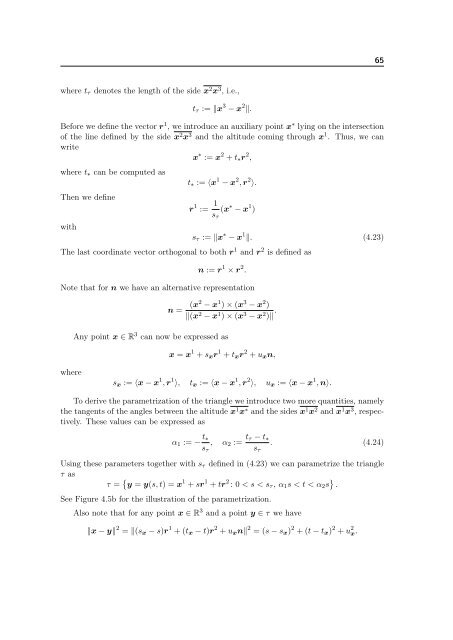The Boundary Element Method for the Helmholtz Equation ... - FEI VÅ B
The Boundary Element Method for the Helmholtz Equation ... - FEI VÅ B
The Boundary Element Method for the Helmholtz Equation ... - FEI VÅ B
Create successful ePaper yourself
Turn your PDF publications into a flip-book with our unique Google optimized e-Paper software.
65where t τ denotes <strong>the</strong> length of <strong>the</strong> side x 2 x 3 , i.e.,t τ := ∥x 3 − x 2 ∥.Be<strong>for</strong>e we define <strong>the</strong> vector r 1 , we introduce an auxiliary point x ∗ lying on <strong>the</strong> intersectionof <strong>the</strong> line defined by <strong>the</strong> side x 2 x 3 and <strong>the</strong> altitude coming through x 1 . Thus, we canwritex ∗ := x 2 + t ∗ r 2 ,where t ∗ can be computed as<strong>The</strong>n we definewitht ∗ := ⟨x 1 − x 2 , r 2 ⟩.r 1 := 1 s τ(x ∗ − x 1 )s τ := ∥x ∗ − x 1 ∥. (4.23)<strong>The</strong> last coordinate vector orthogonal to both r 1 and r 2 is defined asn := r 1 × r 2 .Note that <strong>for</strong> n we have an alternative representationn = (x2 − x 1 ) × (x 3 − x 2 )∥(x 2 − x 1 ) × (x 3 − x 2 )∥ .Any point x ∈ R 3 can now be expressed asx = x 1 + s x r 1 + t x r 2 + u x n,wheres x := ⟨x − x 1 , r 1 ⟩, t x := ⟨x − x 1 , r 2 ⟩, u x := ⟨x − x 1 , n⟩.To derive <strong>the</strong> parametrization of <strong>the</strong> triangle we introduce two more quantities, namely<strong>the</strong> tangents of <strong>the</strong> angles between <strong>the</strong> altitude x 1 x ∗ and <strong>the</strong> sides x 1 x 2 and x 1 x 3 , respectively.<strong>The</strong>se values can be expressed asα 1 := − t ∗s τ,α 2 := t τ − t ∗s τ. (4.24)Using <strong>the</strong>se parameters toge<strong>the</strong>r with s τ defined in (4.23) we can parametrize <strong>the</strong> triangleτ asτ = y = y(s, t) = x 1 + sr 1 + tr 2 : 0 < s < s τ , α 1 s < t < α 2 s .See Figure 4.5b <strong>for</strong> <strong>the</strong> illustration of <strong>the</strong> parametrization.Also note that <strong>for</strong> any point x ∈ R 3 and a point y ∈ τ we have∥x − y∥ 2 = ∥(s x − s)r 1 + (t x − t)r 2 + u x n∥ 2 = (s − s x ) 2 + (t − t x ) 2 + u 2 x.









